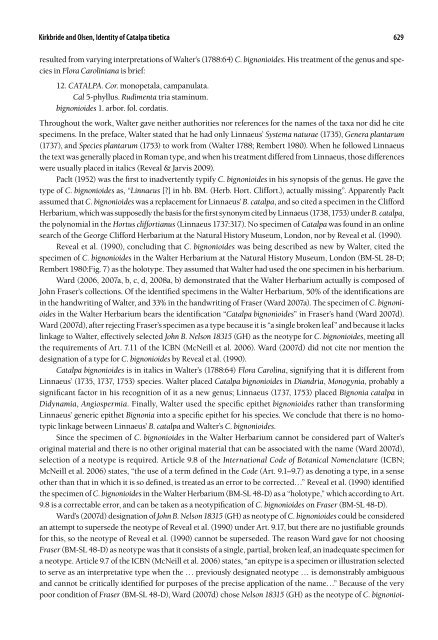J.H. Kirkbride, Jr. R.T. Olsen - Brit
J.H. Kirkbride, Jr. R.T. Olsen - Brit
J.H. Kirkbride, Jr. R.T. Olsen - Brit
Create successful ePaper yourself
Turn your PDF publications into a flip-book with our unique Google optimized e-Paper software.
<strong>Kirkbride</strong> and <strong>Olsen</strong>, Identity of Catalpa tibetica 629<br />
resulted from varying interpretations of Walter’s (1788:64) C. bignonioides. His treatment of the genus and species<br />
in Flora Caroliniana is brief:<br />
12. CATALPA. Cor. monopetala, campanulata.<br />
Cal 5-phyllus. Rudimenta tria staminum.<br />
bignonioides 1. arbor. fol. cordatis.<br />
Throughout the work, Walter gave neither authorities nor references for the names of the taxa nor did he cite<br />
specimens. In the preface, Walter stated that he had only Linnaeus’ Systema naturae (1735), Genera plantarum<br />
(1737), and Species plantarum (1753) to work from (Walter 1788; Rembert 1980). When he followed Linnaeus<br />
the text was generally placed in Roman type, and when his treatment differed from Linnaeus, those differences<br />
were usually placed in italics (Reveal & Jarvis 2009).<br />
Paclt (1952) was the first to inadvertently typify C. bignonioides in his synopsis of the genus. He gave the<br />
type of C. bignonioides as, “Linnaeus [?] in hb. BM. (Herb. Hort. Cliffort.), actually missing”. Apparently Paclt<br />
assumed that C. bignonioides was a replacement for Linnaeus’ B. catalpa, and so cited a specimen in the Clifford<br />
Herbarium, which was supposedly the basis for the first synonym cited by Linnaeus (1738, 1753) under B. catalpa,<br />
the polynomial in the Hortus cliffortianus (Linnaeus 1737:317). No specimen of Catalpa was found in an online<br />
search of the George Clifford Herbarium at the Natural History Museum, London, nor by Reveal et al. (1990).<br />
Reveal et al. (1990), concluding that C. bignonioides was being described as new by Walter, cited the<br />
specimen of C. bignonioides in the Walter Herbarium at the Natural History Museum, London (BM-SL 28-D;<br />
Rembert 1980:Fig. 7) as the holotype. They assumed that Walter had used the one specimen in his herbarium.<br />
Ward (2006, 2007a, b, c, d, 2008a, b) demonstrated that the Walter Herbarium actually is composed of<br />
John Fraser’s collections. Of the identified specimens in the Walter Herbarium, 50% of the identifications are<br />
in the handwriting of Walter, and 33% in the handwriting of Fraser (Ward 2007a). The specimen of C. bignonioides<br />
in the Walter Herbarium bears the identification “Catalpa bignonioides” in Fraser’s hand (Ward 2007d).<br />
Ward (2007d), after rejecting Fraser’s specimen as a type because it is “a single broken leaf” and because it lacks<br />
linkage to Walter, effectively selected John B. Nelson 18315 (GH) as the neotype for C. bignonioides, meeting all<br />
the requirements of Art. 7.11 of the ICBN (McNeill et al. 2006). Ward (2007d) did not cite nor mention the<br />
designation of a type for C. bignonioides by Reveal et al. (1990).<br />
Catalpa bignonioides is in italics in Walter’s (1788:64) Flora Carolina, signifying that it is different from<br />
Linnaeus’ (1735, 1737, 1753) species. Walter placed Catalpa bignonioides in Diandria, Monogynia, probably a<br />
significant factor in his recognition of it as a new genus; Linnaeus (1737, 1753) placed Bignonia catalpa in<br />
Didynamia, Angiospermia. Finally, Walter used the specific epithet bignonioides rather than transforming<br />
Linnaeus’ generic epithet Bignonia into a specific epithet for his species. We conclude that there is no homotypic<br />
linkage between Linnaeus’ B. catalpa and Walter’s C. bignonioides.<br />
Since the specimen of C. bignonioides in the Walter Herbarium cannot be considered part of Walter’s<br />
original material and there is no other original material that can be associated with the name (Ward 2007d),<br />
selection of a neotype is required. Article 9.8 of the International Code of Botanical Nomenclature (ICBN;<br />
McNeill et al. 2006) states, “the use of a term defined in the Code (Art. 9.1–9.7) as denoting a type, in a sense<br />
other than that in which it is so defined, is treated as an error to be corrected…” Reveal et al. (1990) identified<br />
the specimen of C. bignonioides in the Walter Herbarium (BM-SL 48-D) as a “holotype,” which according to Art.<br />
9.8 is a correctable error, and can be taken as a neotypification of C. bignonioides on Fraser (BM-SL 48-D).<br />
Ward’s (2007d) designation of John B. Nelson 18315 (GH) as neotype of C. bignonioides could be considered<br />
an attempt to supersede the neotype of Reveal et al. (1990) under Art. 9.17, but there are no justifiable grounds<br />
for this, so the neotype of Reveal et al. (1990) cannot be superseded. The reason Ward gave for not choosing<br />
Fraser (BM-SL 48-D) as neotype was that it consists of a single, partial, broken leaf, an inadequate specimen for<br />
a neotype. Article 9.7 of the ICBN (McNeill et al. 2006) states, “an epitype is a specimen or illustration selected<br />
to serve as an interpretative type when the … previously designated neotype … is demonstrably ambiguous<br />
and cannot be critically identified for purposes of the precise application of the name…” Because of the very<br />
poor condition of Fraser (BM-SL 48-D), Ward (2007d) chose Nelson 18315 (GH) as the neotype of C. bignonioi-
















